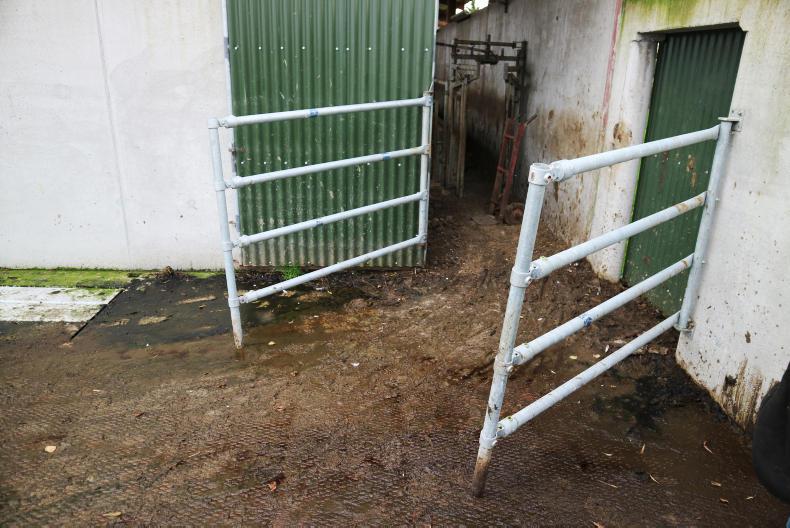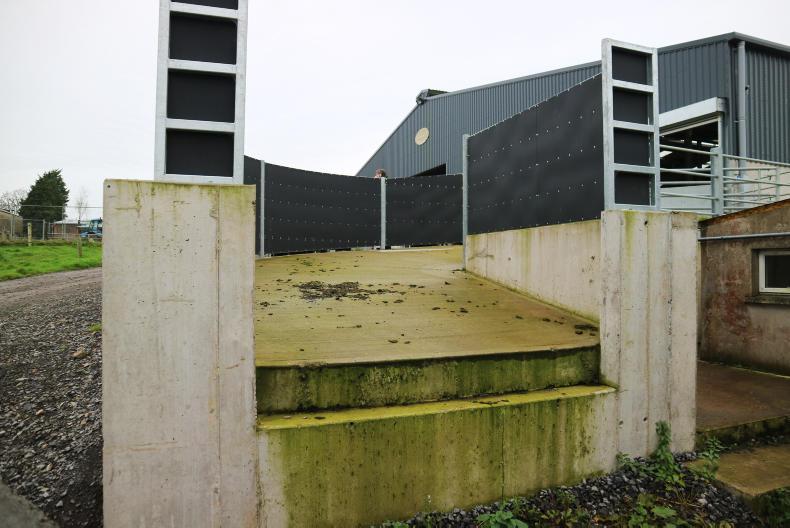Loading ramp for trucks
Many injuries can arise when loading or unloading cattle either from a truck or a trailer. Suitable facilities will greatly increase safety.
Where there is a ramp in place on the trailer, it is vital that they are fitted with ramp gates. These must be strong and secure and lock in securely when closed. Cattle escaping to the sides of a trailer can create big problems.

Designing a loading facility that matches the truck or trailer will greatly improve the ease of loading or unloading cattle.
This setup is ideal for loading cattle into a truck. It is in place on Harte Peat Farms in Co Monaghan. The system is designed to provide optimal flow of cattle and to help prevent cattle from turning back as they are being moved to a truck.
The loading ramp curves down towards where the truck would be positioned. The downward curve is intended to keep cattle moving towards the truck.
The ramp is surrounded by stock board to prevent cattle from being spooked or distracted by movement outside the ramp.
One simple adaption that could be made to improve this loading ramp is to have a grooved floor surface to provide better grip for cattle.
For ramps from trailers, any steps from cattle must be less than 20cm high and the ramp angle less than 150. This would not be an issue with this setup as the truck would be level with the loading ramp. A lip exists on the loading ramp for the door of the truck to sit on.
A man-escape slot is also in place beside the end of the loading ramp. This allows the farmer to close the door of the truck from the ground. It also provides the farmer with a quick exit route if something goes wrong.
Loading chute
The first option will not be realistic for every farmer, but simple changes can be made around your current yard to improve safety when loading cattle.

Mike Dillane, a suckler and beef farmer from outside Lixnaw, Co Kerry, made a change to the door of his finishing shed to make loading bulls easier.
Mike got tired of continuously moving gates to make a chute when loading cattle from his shed. Now when cattle are going to the factory they can reverse up to the two gates and safely load the cattle.
 One gate is fixed to the wall with the other attached to the door of the shed.
One gate is fixed to the wall with the other attached to the door of the shed.
Both gates can move up and down to allow them to sit on the loading ramp of the truck if necessary.
While a simple and cheap option, it is one of the best investments he has ever made on the farm, according to Mike.
Concrete loading ramp
Another option for loading cattle is with the use of a concrete loading ramp as seen here.

High walls ensure that cattle cannot be distracted by movement outside the ramp. The main disadvantage here compared with option one is that cattle can easily turn back on the farmer. Overall, it is still a very safe option for loading cattle. A gate is in place at the bottom of the ramp to prevent cattle from turning back.
Steps
This type of loading system is popular in Australia and America, but such units are not yet common in Ireland. They are predominantly used for loading cattle into articulated trucks.

Cattle walk up steps and enter the truck in single file. A guillotine gate is in place at the top of the ramp. There are two doors at the top of the ramp fitted with rubber along their end. These can be adjusted depending on whether one or both doors of a truck are open. All cattle can be unpredictable, but there are steps that farmers can take to minimise the danger.
Dangerous behaviours can arise from several factors according to the Health and Safety Authority (HSA):
The genetics of the cattle.Past experiences: cattle may have been roughly handled in the past and may be easily agitated.Separation from their normal herd mates – cattle are highly social within their group.From their current activity – such as being cornered, isolated, confined in a crush or being milked for the first time.
Loading ramp for trucks
Many injuries can arise when loading or unloading cattle either from a truck or a trailer. Suitable facilities will greatly increase safety.
Where there is a ramp in place on the trailer, it is vital that they are fitted with ramp gates. These must be strong and secure and lock in securely when closed. Cattle escaping to the sides of a trailer can create big problems.

Designing a loading facility that matches the truck or trailer will greatly improve the ease of loading or unloading cattle.
This setup is ideal for loading cattle into a truck. It is in place on Harte Peat Farms in Co Monaghan. The system is designed to provide optimal flow of cattle and to help prevent cattle from turning back as they are being moved to a truck.
The loading ramp curves down towards where the truck would be positioned. The downward curve is intended to keep cattle moving towards the truck.
The ramp is surrounded by stock board to prevent cattle from being spooked or distracted by movement outside the ramp.
One simple adaption that could be made to improve this loading ramp is to have a grooved floor surface to provide better grip for cattle.
For ramps from trailers, any steps from cattle must be less than 20cm high and the ramp angle less than 150. This would not be an issue with this setup as the truck would be level with the loading ramp. A lip exists on the loading ramp for the door of the truck to sit on.
A man-escape slot is also in place beside the end of the loading ramp. This allows the farmer to close the door of the truck from the ground. It also provides the farmer with a quick exit route if something goes wrong.
Loading chute
The first option will not be realistic for every farmer, but simple changes can be made around your current yard to improve safety when loading cattle.

Mike Dillane, a suckler and beef farmer from outside Lixnaw, Co Kerry, made a change to the door of his finishing shed to make loading bulls easier.
Mike got tired of continuously moving gates to make a chute when loading cattle from his shed. Now when cattle are going to the factory they can reverse up to the two gates and safely load the cattle.
 One gate is fixed to the wall with the other attached to the door of the shed.
One gate is fixed to the wall with the other attached to the door of the shed.
Both gates can move up and down to allow them to sit on the loading ramp of the truck if necessary.
While a simple and cheap option, it is one of the best investments he has ever made on the farm, according to Mike.
Concrete loading ramp
Another option for loading cattle is with the use of a concrete loading ramp as seen here.

High walls ensure that cattle cannot be distracted by movement outside the ramp. The main disadvantage here compared with option one is that cattle can easily turn back on the farmer. Overall, it is still a very safe option for loading cattle. A gate is in place at the bottom of the ramp to prevent cattle from turning back.
Steps
This type of loading system is popular in Australia and America, but such units are not yet common in Ireland. They are predominantly used for loading cattle into articulated trucks.

Cattle walk up steps and enter the truck in single file. A guillotine gate is in place at the top of the ramp. There are two doors at the top of the ramp fitted with rubber along their end. These can be adjusted depending on whether one or both doors of a truck are open. All cattle can be unpredictable, but there are steps that farmers can take to minimise the danger.
Dangerous behaviours can arise from several factors according to the Health and Safety Authority (HSA):
The genetics of the cattle.Past experiences: cattle may have been roughly handled in the past and may be easily agitated.Separation from their normal herd mates – cattle are highly social within their group.From their current activity – such as being cornered, isolated, confined in a crush or being milked for the first time.


 One gate is fixed to the wall with the other attached to the door of the shed.
One gate is fixed to the wall with the other attached to the door of the shed. 








 This is a subscriber-only article
This is a subscriber-only article

















SHARING OPTIONS: